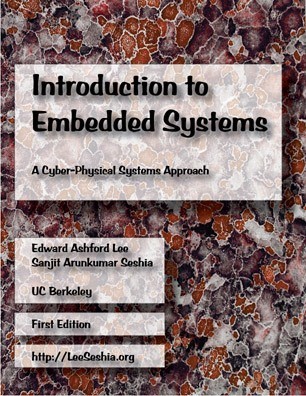
Introduction to Embedded Systems - A Cyber-Physical Systems Approach, First Edition
This book is intended for students at the advanced undergraduate level or the introductory graduate level, and for practicing engineers and computer scientists who wish to understand the engineering principles of embedded systems.
Tag(s): Embedded System
Publication date: 31 Dec 2011
ISBN-10: n/a
ISBN-13: 9780557708574
Paperback: 519 pages
Views: 11,522
Type: Textbook
Publisher: n/a
License: n/a
Post time: 29 Dec 2016 09:30:00
Introduction to Embedded Systems - A Cyber-Physical Systems Approach, First Edition
 This book is intended for students at the advanced undergraduate level or the introductory graduate level, and for practicing engineers and computer scientists who wish to understand the engineering principles of embedded systems.
This book is intended for students at the advanced undergraduate level or the introductory graduate level, and for practicing engineers and computer scientists who wish to understand the engineering principles of embedded systems.
Publication date: 31 Dec 2011
ISBN-10: n/a
ISBN-13: 9780557708574
Paperback: 519 pages
Views: 11,522
Document Type: Textbook
Publisher: n/a
License: n/a
Post time: 29 Dec 2016 09:30:00
Lee and Seshia wrote:Most texts on embedded systems focus on the collection of technologies needed to get computers to interact with physical systems (Barr and Massa, 2006; Berger, 2002; Burns and Wellings, 2001; Kamal, 2008; Noergaard, 2005; Parab et al., 2007; Simon, 2006; Valvano, 2007; Wolf, 2000). Others focus on adaptations of computer-science techniques (like programming languages, operating systems, networking, etc.) to deal with technical problems in embedded systems (Buttazzo, 2005a; Edwards, 2000; Pottie and Kaiser, 2005). While these implementation technologies are (today) necessary for system designers to get embedded systems working, they do not form the intellectual core of the discipline. The intellectual core is instead in models and abstractions that conjoin computation and physical dynamics.
A few textbooks offer efforts in this direction. Jantsch (2003) focuses on concurrent models of computation, Marwedel (2011) focuses on models of software and hardware behav- ior, and Sriram and Bhattacharyya (2009) focus on dataflow models of signal processing behavior and their mapping onto programmable DSPs. These are excellent starting points. Models of concurrency (such as dataflow) and abstract models of software (such as Statecharts) provide a better starting point than imperative programming languages (like C), interrupts and threads, and architectural annoyances that a designer must work around (like caches). These texts, however, are not suitable for an introductory course. They are either too specialized or too advanced or both. This book is our attempt to provide an introductory text that follows the spirit of focusing on models and their relationship to realizations of systems.
More Resources:
Tweet
About The Author(s)
Edward Ashford Lee is Robert S. Pepper Distinguished Professor in the EECS Department at the University of California at Berkeley.

Edward Ashford Lee is Robert S. Pepper Distinguished Professor in the EECS Department at the University of California at Berkeley.
Sanjit A. Seshia is Professor in the Department of Electrical Engineering and Computer Sciences at the University of California, Berkeley. He is part of Group in Logic and the Methodology of Science which develops theory and tools to aid the construction of provably dependable and secure systems. Their work spans several abstraction layers, from mathematical models, through software, to electronic and biological substrates.

Sanjit A. Seshia is Professor in the Department of Electrical Engineering and Computer Sciences at the University of California, Berkeley. He is part of Group in Logic and the Methodology of Science which develops theory and tools to aid the construction of provably dependable and secure systems. Their work spans several abstraction layers, from mathematical models, through software, to electronic and biological substrates.